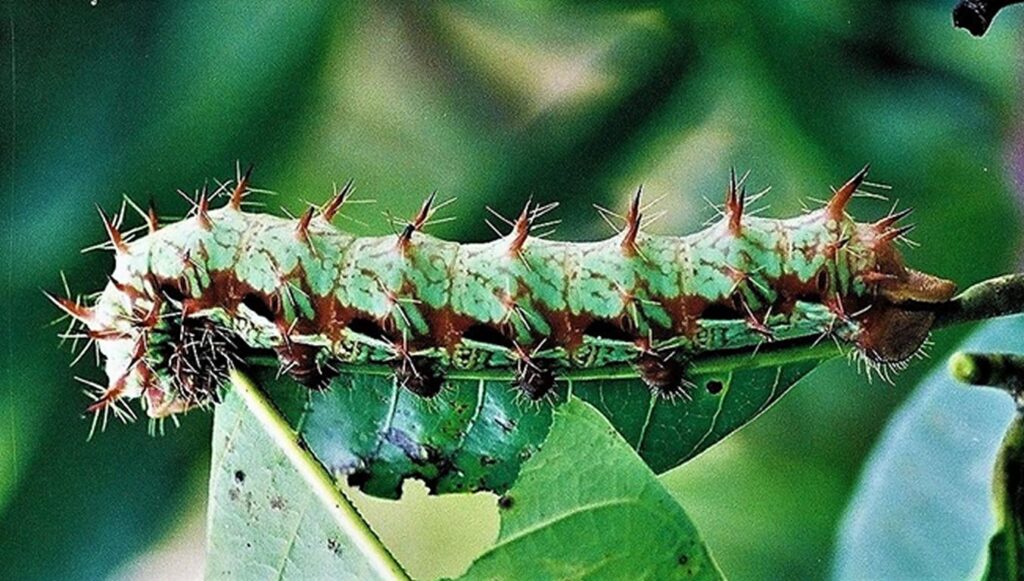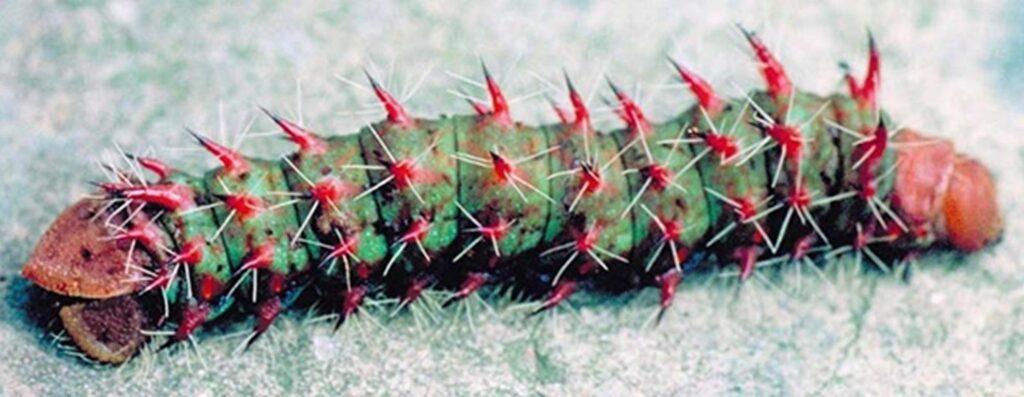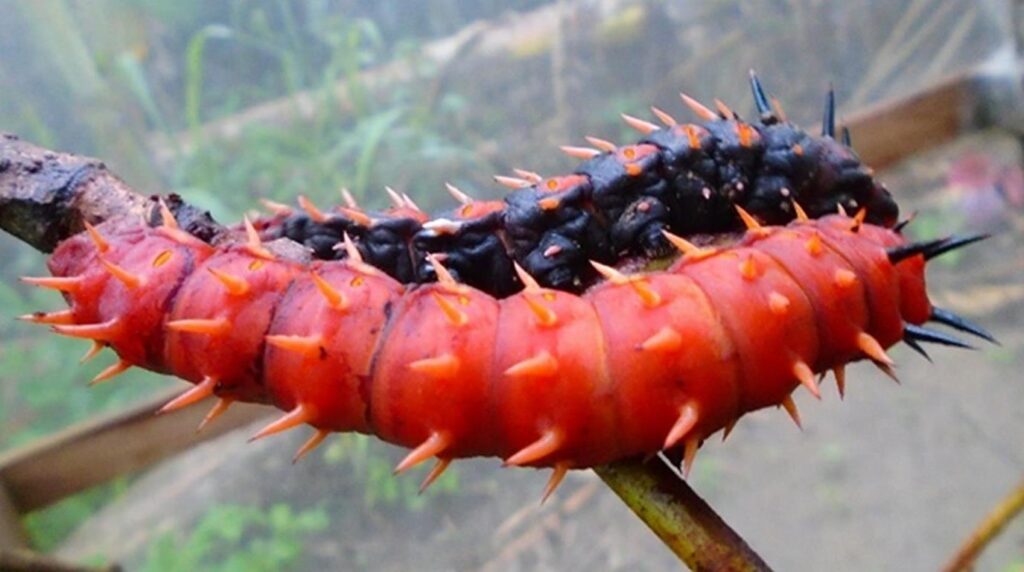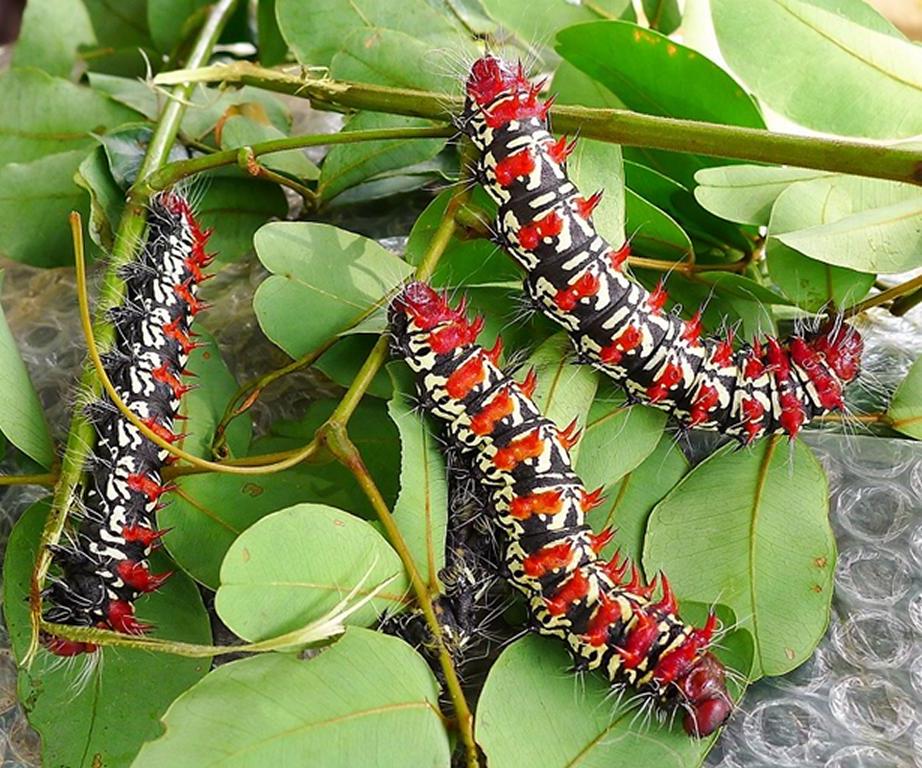In former articles on this website, two edible caterpillar species from Kongo Central were already discussed. One species was ‘Bisu’ Nudaurelia petiveri, which was described here. And the other species was ‘Kaba’ Lobobunaea phaedusa, described at this article there.
In the following, Paul Latham and Augustin Konda ku Mbuta briefly present all other important caterpillar species for food in Kongo Central.
——————————————————————————————————————–
Kindengula, Kidishi foncé (Daphnis nerii)

A solitary species. When disturbed it curls its head and thorax down to display the large eyespots. It feeds on Rauvolfia vomitoria in Kongo Central. Photo: Augustin Konda ku Mbuta
Kitete mbika, Mbua ki siwu (Bunaeopsis licharbas)

This solitary species is found from Senegal to Kenya and south to Zambia. It feeds on Eriosema psoraloides but is known to eat other plants. Photo: Daniel Ambühl
Kwesu (Bunaeoides eblis)
This distinctive caterpillar is usually found in small numbers on a variety of plants, but most frequently on Chaetocarpus africanus. The species is found from Sierra Leone to the Congo and east to Uganda. In Kongo Central it is collected between October and May when it may be heard, crunching the leaves as it eats or as the droppings fall through the leaves. The eggs are large, up to 3 mm long, whitish with brown stripes.


Foodplants include Chaetocarpus africanus, Manotes expansa, Ochna afzelii, Mango, Mangifera indica and Acacia auriculiformis. Pupation takes place in the soil and may remain from 1½ to 2 months during the rainy season. The caterpillar may weigh up to 20 g just before pupation.
Makedi kedi (Bunaea alcinoe)

An important edible caterpillar which is found from October to May in both savanna and forest. There are at least two and maybe three generations per rainy season. Eggs are laid in groups on the undersides of leaves. They hatch after about two weeks and the larvae feed for just over a month. Pupation takes place near the soil surface. When the rains come the pupae are often washed out of the ground. The larvae may have a ground colour of either black or red, both types being found on the same plant.
Food plants are normally Sarcocephalus latifolius, but it also feeds on Acacia auriculiformis, mango, oil palm, Dacryodes edulis, avocado, Crossopteryx febrifuga and Anthocleista schweinfurthii. This caterpillar can be moved from one food plant to another if necessary, for example to an Acacia auriculiformis tree near one’s home, for better protection.


Bunaea alcinoe feeding on Sarcocephalus latifolius. Photos: Augustin Konda ku Mbuta
Malomba loka (Antheua sp.)

This is also an important species, somewhat larger than other Notodontid species referred to below. The caterpillars feed on Millettia eetveldeana and are collected in December and January.
Malumbuka (Antheua sp.)

Malumbuka was seen in January also feeding on Millettia eetveldeana. They sometimes rest head to tail and when disturbed descend on a silk-like thread and remount again later. Photo : Augustin Konda ku Mbuta
Masela, Mimboti, Mimbimbi ya mbwala, Nluti (Elaphrodes lacteal)

A small, gregarious caterpillar which appears in large numbers from the end of November until the start of the dry season. It is sometimes sold in local markets. The food plant is Albizia ferruginea.
Mbambi, Mingo ntulu, Mingo nti (Imbrasia truncate)

The Kikongo name ngo = leopard is given because of the yellow spots present on the young larvae. In Kongo Central it feeds on Harungana madagascariensis. It is often sold with mvinsu caterpillars. Larvae can be moved from one plant to another. Photo: Jurgen Vanhoudt
Mbidi

This species is often found in large numbers. It feeds on Canarium schweinfurthii. The caterpillar is collected in January.
Mfundi (Antheua sp.)

There appear to be at least 4 species known as Mfundi. This one feeds on Millettia eetveldeana and M. theuszii and is found in January.


Miengeti (Phalera sp.)

The larvae feed in large numbers on Millettia eetveldeana and Macaranga monandra. When disturbed they descend from the leaves on a fine silk-like thread. The photograph was taken in January of a caterpillar feeding on Millettia eetveldeana.
Mingombo or Nsielele

This small caterpillar is collected from September to February. It feeds on Kisielele (Pteridium centraliafricanum) a common weed of field crops in Kongo Central.
Minsangula, Lukunku (Achaea catocaloides)
While most species of edible caterpillar remain in one area, providing they are not disturbed by over collection, fire, or loss of their food plant, Minsangula appear in large numbers in completely different areas. They may commence feeding on Pentaclethra eetveldeana but will then move on to eat the leaves of most plants, giving rise to the saying “Nsangula ka ziluti nti!” (Nsangula don’t spare any trees).

If the caterpillars are found on plants low enough to reach, they can be ‘called’ by shouting ‘Yi! Yi’. This causes them to jerk from side to side and thus identify themselves to the collector. If in a high tree they are sometimes smoked down. The caterpillars are collected from October to December and are usually only found where the forest has been allowed to grow for a reasonable length of time.

A Kikongo proverb states that:- “The forest which has not yet reached maturity cannot attract the Minsangula”. It used to be the custom, following the harvest of Minsangula caterpillars, the chief would give authority for the forest to be cut down for planting crops. The larvae also have the habit of descending on fine threads in a similar way to Miengete.
Minsendi (Gonimbrasia jamesoni)
Minsendi is a name given to several species with similar markings and having spines shaped like horns (Minsendi = horn). These are forest species.

Gonimbrasia jamesoni has white or yellow markings made up of small platelets whereas in Imbrasia obscura these are in the form of bands or stripes. The white hairs are also longer in this species.

Minsendi (Imbrasia obscura)
Note the different form of the white markings and the longer hairs in this photo. Eggs of I. obscura are laid along twigs and leaf petioles.

Caterpillars appear from October to February. Pupation takes place underground. Gut contents are removed before cooking.

Foodplants include Pentaclethra macrophylla, Macaranga monandra and Albizia ferruginea. Sometimes young caterpillars are transferred to an Acacia auriculiformis tree near the home village to rear until mature.

Minsendi noir (Nudaurelia rhodian)

Although not particularly common this slow-moving species is appreciated and was found in January feeding on Maesobotrya vermeulenii, a straggling bush which frequently grows near water or in shade.
Minsendi, M’bua kisiwu (Nudaurelia rectilineata)
Usually found in small numbers but an important species in eastern D.R. Congo.

The caterpillars also feed on Diplorhynchus condylocarpon, Cajanus cajan, Erythrophleum africanum, Syzygium guineense subsp. macrocarpum, Antidesma membranaceum and Hymenocardia acida.

More articles on this website about caterpillars can be found via the following links:
Edible caterpillars in D.R. Congo, Introduction
Edible caterpillars in D.R. Congo, Part 2
Edible caterpillars Nudaurelia sp.
Collection of edible caterpillars in D.R. Congo
Edible caterpillars for food in Congo
Stinging nettle slug caterpillar in Vietnam
Green caterpillars, called ‘Kaba’
___________________________________________________________________________________________________________
Text and all photos at this article © Paul Letham. The professional background and contact information of the author of this article, can be found here.
.






1 comment
August King
Thank you very much for this article. I found a lot of Masela, mimboti, mimbimbi ya mbwala, nluti, Elaphrodes lacteal in my back yard, but wasn’t sure if they are edible. Your write-up has clarified.